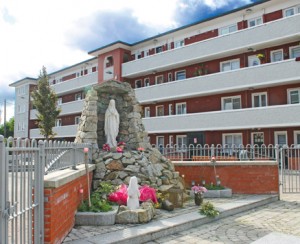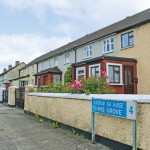
While we all should know that Pearse Street is named after Padraig Pearse, it’s not as obvious that other streets in the area, and a lot of social housing, is named after others who died in the 1916 Rising.
An armed rebellion was staged during Easter week by Irish republicans hoping to end British rule in Ireland. The leaders were executed. Pearse was one of the first to be killed, on May 3rd at Arbour Hill Barracks. Pearse Street, which used to be called Great Brunswick Street was re-named in 1923, after the man himself.
O’Rahilly House, a block of flats built in Ringsend in 1936, twenty years after the rising, on Thorncastle Street was named in honour of Michael Joseph O’Rahilly (1875–1916), or more commonly known as ‘The O’Rahilly’. The O’Rahilly, a Kerryman, adopted his name as a de-anglicising measure. It means ‘head of the O’Rahilly Gaelic Clan’. Despite his efforts to prevent the rising, when he heard of the plan to march on the GPO on Easter Monday morning he decided to join them. He drove from 40 Herbert Park, Dublin 4, into town to join Pearse and the other leaders at Liberty Hall. Arriving in his red sports car he allegedly said; “Well, I’ve helped to wind up the clock – I might as well hear it strike!” He was the only leader of the Easter Rising to die in action. While evacuating the burning GPO he was shot dead on Henry Place.
Neighbouring Whelan’s House, also built in 1936, was named in memory of Patrick Whelan, a local Dublin 4 man and active Gaelic Leaguer who was killed in the cross fire between Bath Avenue and Trinity College, near Boland’s Mill. Boland’s Mill was another key location in the Rising, led by De Valera, and is now the site of the Treasury Buildings on Barrow Street.

A local young man, Edward Ennis, who was accidentally killed while watching the crossfire on the railway between Bath Avenue and Trinity College, gave his name to Ennis Grove.
Macken Street, previously Clarence Street, was renamed in 1923 after Peadar Macken, who was also accidentally shot in the fighting at Boland’s Mills.
Malone Gardens – a small estate off Bath Avenue built between 1928 and 1929, was named for Michael Malone, a volunteer, who had been a member of De Valera’s Boland’s Mill battalion. On Wednesday he led a small number of men towards Mount Street Bridge (a key crossing point into Dublin city) to prevent British reinforcements from entering Dublin. Once there he was stationed at Number 25 Northumberland Road with a handful of others. They held off the British for five hours. But the lower half of the house was bombed and the upper half was stormed by the British Troops and it was here Malone died, in the bloody battle of Mount Street Bridge.
Also involved in the battle of Mount Street Bridge was Section Commander George Reynolds who occupied Clanwilliam House, a large three storey Georgian building that commanded an excellent view of Mount Street Bridge and Northumberland Road. Reynolds fell dead at the window of Clanwilliam House before it was set on fire. George Reynolds House was built in 1950, is in three blocks and is named after the man born in Ringsend.
Pictured: George Reynolds House and Ennis Grove.
By Emma Dwyer

